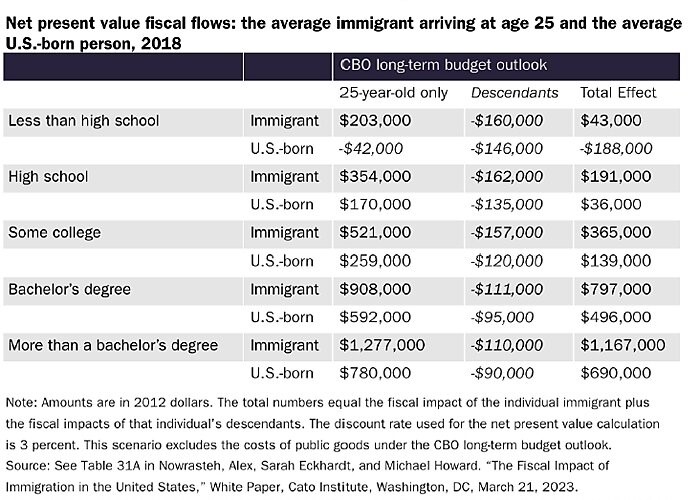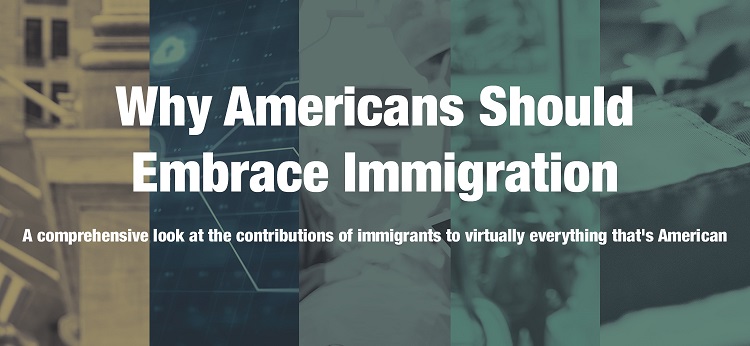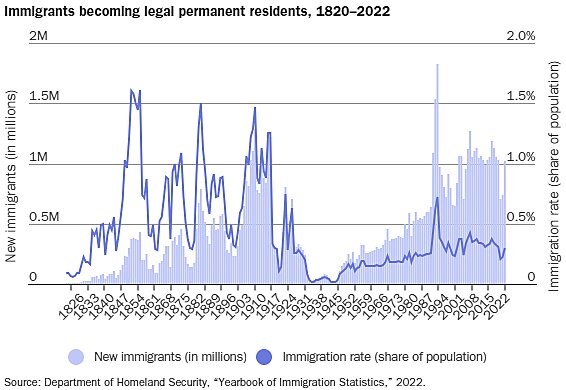Extracts from Cato Institute’s Associate Director of Immigration Studies David J. Bier’s testimony at Sept. 13, 2023, hearing of Committee on the Budget United States Senate, Washington, D.C.)
David J. Bier is Associate Director of Immigration Research at Cato Institute. Photo: cato.org
Our view is simple: people are the ultimate resource. New people are not threats to suppress but assets to celebrate. We need people to transform natural resources into human resources, and in a free country, people seek to do just that. Immigrants are no different. Immigrants are workers, inventors, investors, and entrepreneurs.
Immigrants increase the supply of labor, which increases the supply of goods and services that people need; their consumption, entrepreneurship, and investment also increases the demand for labor, creating better‐paying jobs for Americans elsewhere in the economy. Fundamentally, immigrants aren’t competitors. They are collaborators. Unfortunately, America’s immigration system fails to recognize this fact, leading to catastrophic consequences.
Immigrants can save the United States from population decline.
The most critical challenge facing the United States today is its declining population growth rate. The U.S. population is growing slower than at any point in its history. Moreover, in 2022, international migration accounted for 80 percent of the meager 0.4 percent population growth.1 Without immigration, the U.S. population will start to decline by the 2030s. Already in 2022, about half of all the counties in the United States saw declining populations.
People are necessary to maintain buildings, roads, schools, hospitals, and businesses because population decline erodes property values and forces business and school closures. This population death spiral has afflicted both urban and rural counties. Rural America saw a decrease in population for the first time in U.S. history in the last decade.3 Population aging or decline will reduce tax revenue per capita in nearly every state by 2030.
The country has already seen how population decline will manifest in the future. Major cities saw significant outmigration in the 1960s and 1970s before they stabilized and rebounded in the 1990s and 2000s, largely thanks to new immigrants. The outmigration led to housing vacancies and job losses, which contributed to increased crime, and the in‐migration went hand in hand with lower crime and more business creation. Immigration has already created or preserved $3.7 trillion in housing wealth for U.S. households.6 Immigrants do this primarily by preventing declines in housing values in the lowest‐cost areas in a city. Every 1,000 new immigrants to a county create economic opportunities for 270 additional U.S. residents, helping draw areas out of decline.
Immigrants can save America from labor force decline.
With slower population growth, labor force growth in the United States has also declined for decades, falling by 65 percent from the 1960s—when the immigrant share of the U.S.population bottomed out—to the most recent decade. It fell faster among those without a college degree. From 1995 to 2022, immigrants and their children accounted for 70 percent of labor force growth, and over the last two years, immigrants accounted for 100 percent of the increase in the working‐age population. Without immigrants, the working‐age population will fall by about 6 million in the next two decades. The total U.S. population would decline without any immigration by 2040.10
The costs of this decline are huge. The ratio of workers to retirees has plummeted since the 1960s, and the Social Security Trustees now estimate that Social Security will be short nearly 35 million workers to fund the system in the 2030s. It will have to cut benefits by at least 23 percent in 2034, if not earlier. The situation will not improve after that with benefit cuts reaching 30 percent and the shortfall in workers hitting 80 million by 2080.
The present value cost of this worker shortage to U.S. retirees is about $24 trillion. Of course, the underlying dynamics of Social Security need reforms regardless, but this shortfall highlights the magnitude of America’s workforce issues. The Federal Reserve Board of Governors expects that the decline in population growth will cause economic growth to decline throughout OECD member countries, including the United States, increasing the burden of the U.S. debt.
Immigrants improve the U.S. fiscal situation. According to a Cato Institute update of a National Academy of Sciences report, immigrants generate, in inflation‐adjusted terms, nearly $1 trillion in state, local, and federal taxes, which is almost $300 billion more than they receive in government benefits, including cash assistance, entitlements, and public education.
In the long‐term, the present value of all the taxes generated minus all the benefits received for an immigrant arriving at age 25 is positive for all education levels, including high school dropouts (Table below). This positive result occurs partly because immigrant workers cause companies to invest more in capital, which results in those companies paying far more in taxes than they would without those workers.
 The Congressional Budget Office (CBO) found in 2013 that comprehensive immigration reform would have “a net savings of about $175 billion over the 2014–2023 period” and “would decrease federal budget deficits by about $700 billion (or 0.2 percent of total output) over the 2024–2033 period.” The CBO stated that there would be about another $300 billion in savings from the indirect economic effects of more workers. Unfortunately, this scoring was a rare exception to CBO’s normal practice of not considering the increases in employment that occur when immigrants enter the labor force, leading to such anomalies as finding that immigrant PhDs will impose net costs on the federal government.
The Congressional Budget Office (CBO) found in 2013 that comprehensive immigration reform would have “a net savings of about $175 billion over the 2014–2023 period” and “would decrease federal budget deficits by about $700 billion (or 0.2 percent of total output) over the 2024–2033 period.” The CBO stated that there would be about another $300 billion in savings from the indirect economic effects of more workers. Unfortunately, this scoring was a rare exception to CBO’s normal practice of not considering the increases in employment that occur when immigrants enter the labor force, leading to such anomalies as finding that immigrant PhDs will impose net costs on the federal government.
Tax revenues grow when more is produced, and lower production is the biggest cost of all from an overly restrictive immigration system. Workers allow businesses to increase production, supplying the needs of U.S. consumers. Children and the elderly tend to increase inflation, while workers tend to lower it. This is because children and retirees produce no consumer products but still buy them, while workers lower prices by increasing the production of consumer goods and services. As the U.S. labor force shrinks, this problem will become more acute, driving up costs for seniors and everyone else.
Immigrants can fill current labor shortages.
Throughout the current labor shortage, especially in 2021 and 2022, U.S. consumers were acutely aware of the interaction between workforce shortages and higher inflation every time they faced delays and higher prices at restaurants, retailers, and online. Currently, U.S. nonfarm employers have about 9 million open jobs, and over the last two and a half years, this number has averaged about 10 million. Every single month after January 2021 had more job openings than any month before it, back to the start of the job openings data series in the year 2000. Filling these jobs would have increased U.S. gross domestic product by about $2 trillion. This additional production of goods and services that consumers want is the reason that new workers reduce inflation, not because they lower wages. Of course, any individual worker benefits if they alone receive a monopoly over an area of business, but monopolies hurt everyone else, and when applied to the entire economy, this type of economic policy harms everyone, including those who receive “protection.”
Immigrants fill labor market niches across the skill spectrum.
The short‐ and long‐term labor shortfall is not primarily about a skills gap. Labor demand has increased and will increase across the skills spectrum. Everything from construction laborers to web developers has seen unprecedented increases in open jobs. Every single industry averaged more job openings in 2023 than in 2019—which was already at near‐record highs.
Construction has averaged 354,000 job openings per month in 2023 while manufacturing has averaged 650,000. A major project—funded partly by U.S. taxpayers—to build a new TSMC microchip manufacturing facility in Arizona is already being delayed because of a shortage of experienced workers in the construction trades. Leisure and hospitality averaged 1.4 million. Trade, transportation, and utilities had over 1.6 million. Education and health services were nearly 2 million.
In the long‐term, the Bureau of Labor Statistics predicts that most jobs created this decade will not require a college degree, and that nearly 70 percent of jobs in the economy will not require a college degree in 2030. Besides lifting the production of goods and services that U.S. consumers need, immigrant workers in these positions create new opportunities for U.S. workers in other less manually intensive jobs—typically ones that require English language abilities. Immigrants complement Americans. They don’t replace them. This is one reason why U.S. worker employment has almost always moved in the same direction as immigrant employment.
With 1 million new jobs, home health aides are projected to see the largest increase in employment of any single occupational category. These aides are critical to provide care for seniors, and they allow many older workers to keep working while caring for an ailing spouse. But without the workers to fill them, the growth in aides may not happen. America has even seen declines in employment in critical areas of elder care, despite record demand. Shockingly, for instance, the number of employees in skilled nursing care facilities has declined from 1.7 million to 1.4 million from 2011 to 2023.
Many nursing homes are closing because they cannot properly staff their operations—particularly in rural areas. In Minnesota alone, 45 facilities have closed. Another 60 have closed in Texas. There were 22 closures in Iowa in the last year alone. In Rhode Island, according to the American Health Care Association, nursing homes have lost 21 percent of their staff since 2019.29 Five have already closed, and most are at risk of closing.
At open facilities, huge numbers of beds remain empty, with the vacancies nationwide reaching 32 percent. An analysis of nursing homes by researchers from Harvard, MIT, and Rochester showed that, “increased immigration significantly raises the staffing levels of nursing homes in the U.S., particularly in full‐time positions,” which results in better patient outcomes. The National Council of the State Boards of Nursing has found that 800,000 nurses plan to leave the labor force by 2027.
One reason why Americans are having fewer children is the cost of childcare. The cost of childcare directly reduces the growth in the future labor force and indirectly reduces the growth in the labor force by driving mothers to drop out of the labor force. A majority of mothers with young children are not looking for jobs solely because of childcare or family responsibilities. A staffing crisis has caused massive wait lists for care in states across the country. In Pennsylvania, 7,000 open positions have led to 32,500 kids waiting for care. It’s worse in Michigan, where nearly 54,000 kids are waiting.
Researchers Delia Furtado and Heinrich Hock have found that low‐skilled immigrants have “substantially reduced” the costs of having a child. Patricia Cortés and José Tessada similarly find, “low‐skilled immigration increases average hours of market work and the probability of working long hours of women at the top quartile of the wage distribution.” Allowing higher‐income women to work has important knock‐on fiscal and economic benefits because they have above‐average productivity.
New home construction—a critical component in family formation—has also suffered from too few workers. Construction employment has reached record highs, while construction unemployment is at near‐record lows. Construction industry wages are now higher than the average wage for workers generally.
The United States is also facing critical shortages of skilled workers. For physicians per capita, America ranks far behind Germany, Sweden, Australia, and Switzerland, and it has half the number of physicians per capita as Austria—effectively a difference of nearly 1 million physicians.
In rural areas, the shortages are dire. A study in the journal Health Affairs has shown that rural patients are far more likely to die because they lack the number of specialists to treat them effectively. This situation would be even worse if not for immigrants, who account for a quarter of all U.S. physicians.44 Skilled science, technology, engineering, and math workers are also in short supply. There are about half a million open computer and mathematics jobs in the United States right now, and the unemployment rate for these jobs is at 2 percent. McKinsey estimates that chip manufacturers will be short 390,000 engineers and skilled technicians by 2030, leading to more production being set up offshore. In 2020, the Defense Department issued a report saying that the shortfall of computer workers “directly threatens U.S. national self‐determination in commerce and geopolitics.”
Since 2019, the Department of Labor has certified over 250,000 computer and mathematics jobs as unfillable by any U.S. worker, which is the first step of the employment‐based green card process. But most of these workers have entered the green card backlog, and the U.S. immigration system is so poorly designed that engineers from Venezuela have been entering at the U.S. border.
Immigrants can supercharge entrepreneurship and innovation.

As the U.S. population has aged, the entrepreneurship rate has declined. There has been a 40 percent decline in the rate of new business starts since the 1970s, and the rate of self‐employed entrepreneurs has likewise halved. Immigrants can counteract these drags on the economy. Immigrants are 80 percent more likely to start businesses than the U.S.-born population. Over 35 percent of new businesses have at least one immigrant founder, and they or their children founded 45 percent of Fortune 500 companies. Immigrants have founded the majority of businesses valued at more than $1 billion.
Immigrants also make up a disproportionate 28 percent of brick‐and‐mortar “main street” businesses nationwide. In many major metropolitan areas, immigrants account for about half of all main street businesses. Immigrants own astounding shares of small businesses in New York City: 90 percent of dry cleaning and laundry services, 84 of grocery stores, 75 percent of child daycares, and 69 percent of restaurants.55
Immigrants are key to productivity growth and innovation. Immigrants have founded 65 percent of the leading U.S. artificial intelligence companies. Over 70 percent of $1 billion U.S. companies employ an immigrant in a key leadership position, such as CEO or chief technology officer. Immigrant‐founded companies are also much more likely to have patents. From 1950 to 2000, immigrants with science and engineering degrees had patent rates double the average rate. The best estimate indicates that about 40 percent of total factor productivity growth—growth not from increases in labor or capital—came from immigrant workers in science, technology, engineering, and math degrees.
U.S. law thwarts legal immigration.
Immigrants are more likely to work than U.S.-born workers overall and at every education level—a difference that grows significantly among the least skilled—and nearly 97 percent of immigrants who looked for jobs in 2022 found them. Immigrant adults without high school degrees are about 20 percentage points more likely to work than comparable U.S.-born adults. The issue is not that immigrants lack the desire to help America. Rather, the issue is that America’s immigration system prevents too many potential immigrants from being able to do so. To briefly review the main permanent immigration options available for immigrants abroad:
- The Refugee Program: The population of displaced people reached 100 million last year, and the United States accepted barely 25,000 through its refugee program—0.1 percent.62
- Family‐sponsored: The capped family‐sponsored system has a backlog of over 8.3 million, and 1.6 million immigrants currently waiting will be dead before they can receive a green card.
- Employer-sponsored: Employer‐sponsored green cards are capped at 140,000 annually and have a backlog of over 1.8 million. The country‐based caps mean that wait times for Indian workers with a master’s degree will be longer than the average lifespan. Employer‐sponsored green cards are close to impossible to obtain for those without very high wage offers and a work visa, and the main work visa—the H‑1B—is capped at 25 percent of demand. For those coming temporarily, the H‑2B seasonal worker program for nonagricultural jobs is the only path for most U.S. seasonal low‐skilled jobs, and it has an annual cap of 66,000. Although Congress temporarily doubled this cap year, that level was only about half the level required to meet the number of positions requested.
- Diversity Lottery: The diversity green card lottery is available to immigrants only if they are notfrom legal immigrants’ main origin countries and have a high school degree or experience in a skilled job, and it offers entrants just a 0.2 percent chance of receiving a green card.
Note that there is no option for entrepreneurs. This high‐level review does not represent the complexity and restrictiveness of the system. The figure below details the legal requirements to immigrate to the United States in a flow chart. Many aspiring Americans are excluded with each section until nearly everyone loses their chance to immigrate. In 2023, about 34 million people entered a legal process to try to obtain a green card, and barely more than 1 million will receive legal permanent residence.
This massive disparity between green cards issued and green cards requested is a consequence of decades of unnecessarily low green card caps, leading millions to have no viable way to enter the U.S. legally. From 1848 to 1914, the annual number of people receiving green cards hit one percent of the U.S. population 22 times. It has never happened since the Immigration Act of 1924, and only once has it even hit half that rate, when Congress waived the caps on behalf of 3 million illegal immigrants in the Immigration Reform and Control Act of 1986. One percent of the U.S. population today would be nearly 3.4 million people. The number of green card recipients in 2022 was just 1 million.70
 Immigration policy is also restrictive compared to our peer nations. The United States went from accounting for the majority of the increase in the world immigrant population in the 1990s to accounting for just 7.5 percent of it from 2015 to 2020. This happened both because more immigrants went to other countries and because fewer immigrants went to the United States.
Immigration policy is also restrictive compared to our peer nations. The United States went from accounting for the majority of the increase in the world immigrant population in the 1990s to accounting for just 7.5 percent of it from 2015 to 2020. This happened both because more immigrants went to other countries and because fewer immigrants went to the United States.
Less than 15 percent of the U.S. population was born outside the United States. This ranks 56th highest in the world. It ranks in the bottom third of wealthy countries in the world, and the gaps are massive. To catch up to Canada (21.4 percent), nearly 30 million immigrants would have to arrive this year. To reach the immigrant share in Australia (30.3 percent), the number grows to 76.4 million. To hit Hong Kong’s percentage (39.2 percent), it would have to exceed 140 million. These totals are unfathomable, but they illustrate how much flexibility the United States has when it comes to changing its immigration policy and remaining well within the norms for the wealthy world.
…Conclusion
The most important economic challenge facing the United States right now is the decline in population and labor force growth. Fewer workers mean less production, higher prices, and lower tax revenues. Immigrants stand ready to address this challenge. Congress should focus on increasing legal immigration and assuring that workers already in the country can fully and legally contribute to this country.











